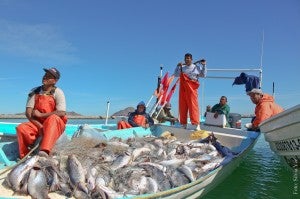Revitalizing the Mexican Corvina Fishery with Sustainable Management

For many years the short, six week commercial Corvina fishing season in the Upper Gulf of California was marked by a frenzied race to fish, with as many as 600 boats in the water at the same time. Beginning in late February, and aligned with moon cycles, this species gathers in the Colorado River delta to spawn, a yearly ritual eagerly awaited by the local fishermen. And so every year, with so much fish to be had, and so many fishermen, thousands of tons would hit the market simultaneously. This drove the price down and resulted in even more fishing effort, which would even further depress prices – to values below that of a recycled plastic bottle. It was a vicious cycle that has become all too familiar in fisheries in Latin America and around the world. Scientists have long advised that, if unchecked, this way of fishing could lead to the complete collapse of Corvina, having dire consequences for a region with very limited economic alternatives. It is estimated that Corvina represents as much as 60% of all fish sold in Mexico City during this time of year, coinciding with Lent, when seafood consumption is highest.
Three years ago EDF, fishermen, and critical partners like Noroeste Sustentable (NOS), the Academy for Systemic Change, and the state and federal governments, set out to bring catch share management to this fishery to give fishermen and others a stake in its biological and economic success.
In 2012 a new system was put into place: a scientifically-based Total Allowable Catch (a limit on the amount of fish that can be caught) was published ahead of the season, and the first-ever co-management agreements were brokered in the largest fishing community – Golfo de Santa Clara, which represents roughly 80% of the total catch – that included a price agreement and a per-tide, per-skiff allocation. Central to the good preliminary results of this new system was the agreement reached with leading stakeholders in the region, including Guillermina García and other important local seafood buyers. Ms. García and her peers agreed to a price floor in exchange for the fishermen’s promise to stick to their allocation and not flood the market, allowing the buyers to time their supply to the market in Mexico City. The agreements worked and the price floor held for most of the season. Our initial analysis suggests that fishermen made more money while catching approximately 50% fewer fish over the same period of time.
Dinora Gallardo, a local businesswoman, explained the end result best:
“This system is worth it, and we are spending less. Before, we were paid 4-6, maybe 8 pesos per kilo. Now we are catching less, but if you make the calculations with the limited catch, and the higher price, we are actually making more, especially because we are out fishing less.”
EDF and partners are working at full capacity to prepare for the 2013 season, which is expected to begin in early March. We are working to bring three other important communities into this system, including the indigenous Cucapá community, and Sonora, San Felipe and Bajo Rio. All hands are on deck at EDF to study and utilize the legal and regulatory frameworks to make formalize this system for long-term conservation and socio-economic success.
Guillermina García is excited about the upcoming 2013 season and says: “We have to get to work on the community agreements like last year! The key to making the quota system work is making sure that the price holds steady.”
We couldn’t agree more.










